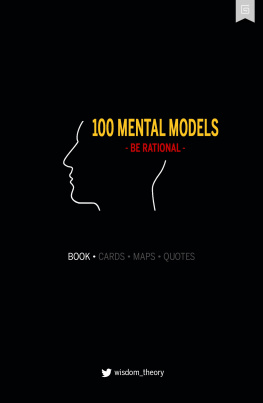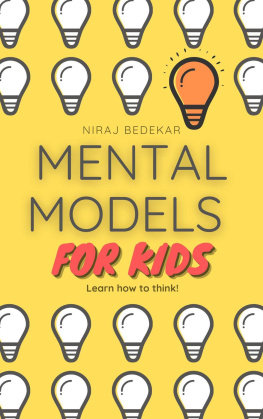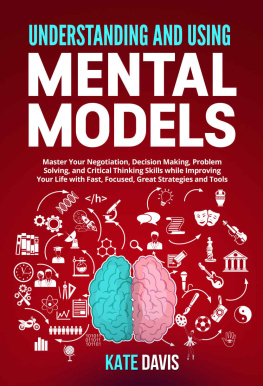Rhiannon Beaubien - The Great Mental Models Volume 3: Systems and Mathematics
Here you can read online Rhiannon Beaubien - The Great Mental Models Volume 3: Systems and Mathematics full text of the book (entire story) in english for free. Download pdf and epub, get meaning, cover and reviews about this ebook. year: 2021, publisher: Latticework Publishing Inc., genre: Politics. Description of the work, (preface) as well as reviews are available. Best literature library LitArk.com created for fans of good reading and offers a wide selection of genres:
Romance novel
Science fiction
Adventure
Detective
Science
History
Home and family
Prose
Art
Politics
Computer
Non-fiction
Religion
Business
Children
Humor
Choose a favorite category and find really read worthwhile books. Enjoy immersion in the world of imagination, feel the emotions of the characters or learn something new for yourself, make an fascinating discovery.

- Book:The Great Mental Models Volume 3: Systems and Mathematics
- Author:
- Publisher:Latticework Publishing Inc.
- Genre:
- Year:2021
- Rating:4 / 5
- Favourites:Add to favourites
- Your mark:
- 80
- 1
- 2
- 3
- 4
- 5
The Great Mental Models Volume 3: Systems and Mathematics: summary, description and annotation
We offer to read an annotation, description, summary or preface (depends on what the author of the book "The Great Mental Models Volume 3: Systems and Mathematics" wrote himself). If you haven't found the necessary information about the book — write in the comments, we will try to find it.
The Great Mental Models Volume 3: Systems and Mathematics — read online for free the complete book (whole text) full work
Below is the text of the book, divided by pages. System saving the place of the last page read, allows you to conveniently read the book "The Great Mental Models Volume 3: Systems and Mathematics" online for free, without having to search again every time where you left off. Put a bookmark, and you can go to the page where you finished reading at any time.
Font size:
Interval:
Bookmark:

FS is devoted to helping you go to bed smarter than when you woke up.
Our weekly newsletter is one of the most popular in the world. Every Sunday we share timeless ideas and actionable insights that drive results in work and life.
Sign up at fs.blog/newsletter.
fs.blog

Mental models help you see the world as it is, not as you want it to be. When you see the world as it is, you can more easily align yourself with it. Suddenly you have a tailwind instead of a headwind.
When I started FS, one of my goals was to share the tools that have changed my life with the world. Accomplishing that is what led us to create the Great Mental Models project. This book series aims to help equalize opportunity in the world by making a high-quality, multidisciplinary, interconnected education free and available to everyone.
We know its a big ambition, and were glad we have a partner who shares our vision. The physical books wouldnt be possible without Automattic, an amazing company dedicated to giving great ideas a voice and a global platform. Like us, they believe knowledge is meant to be shared as widely as possible, and were grateful for their support. (Check out their Afterthoughts on page 369.)
To each and every reader, I want to thank you for your curiosity. Im so excited that you are on this journey with us. To learn more about the Great Mental Models project, visit fs.blog/tgmm.
Shane Parrish
Founder of FS
Published in 2021 by Latticework Publishing
201-854 Bank Street, Ottawa, K1S 3W3
Copyright Farnam Street Media Inc.
Creative direction by Garvin Hirt and Morgwn Rimel
Designed and typeset by FLOK, Berlin
Illustrations by Marcia Mihotich, London
Printed in Latvia by Livonia Print
Ebook design by Bright Wing Media
All rights reserved.
A portion of this work has appeared online at fs.blog.
While every effort has been made to contact copyright holders, if we have overlooked anything, please let us know. This book wouldnt be possible without the insights of others. The goal of FS is to master the best of what other people have figured out. True to this mission, everything in here began with someone else.
Any reproduction of this book requires written permission.
www.fs.blog
Book ISBN: 978-1-9994490-6-3
Ebook ISBN: 978-1-9994490-7-0


In Volume I of The Great Mental Models, we introduced nine general thinking concepts to get you started on the journey of building a latticework of timeless knowledge. Time and again those models have proven indispensable in both solving problems and preventing them in the first place.
In Volume II of The Great Mental Models, we continued the journey and explored fundamental ideas from physics, chemistry, and biology. The truths about the physical world, from the forces that allow us to manipulate energy to the behaviors that drive the actions of all organisms, are constants that can guide our decisions so that our actions are aligned with how the world works.
How much you know in the broad sense determines what you understand of the new things you learn.
Hilde stby and Ylva stby
In this book, Volume III, we will consider some of the basics of systems thinking and mathematics. Although these subjects can appear abstract, as soon as we start taking them apart, we quickly see that they describe so many of the behaviors and interactions that govern our lives. We hope you are excited about embarking on this next step of the journey.
The more moving parts you have in something, the more possibilities there are.
Adam Frank
The Great Mental Models series is designed to inspire and challenge you. We want to give you both knowledge and a framework for making it useful.
One of our goals for the series is to provide you with a set of tools built on timeless knowledge that you can use again and again to make better decisions. It is a guide to dozens of mental models, spread across multiple volumes, that define and explore the foundational concepts from a variety of disciplines. We then take the concept out of its original discipline and show you how you can apply it in less obvious situations. We encourage you to dive into new ideas to augment your knowledge toolbox but also to leverage what you already know by applying it in new ways to give yourself a different perspective on the challenges you face.
In the first book, we explained that a mental model is simply a representation of how something works. We use models to retain knowledge and simplify how we understand the world. We cant relearn everything every day, so we construct models to help us chunk patterns and navigate our world more efficiently. Farnam Streets mental models are reliable principles that you can see at work in the world time and again. Using them means synthesizing across disciplines and not being afraid to apply knowledge from different areas far outside the milieu they usually cover.
Not every model applies to all situations. Part of building a latticework of mental models is educating yourself regarding which situations are best addressed by which models. This takes some work, and youre likely to make some mistakes. Its important to constantly reflect on your use of models. If something didnt work, you need to try to discover why. Over time, by reflecting on your use of individual models, you will learn which models will best help you tackle which situations. Knowing why a model works will help you know when to use it again.
Systems thinking is a discipline for seeing wholes. It is a framework for seeing interrelationships rather than things, for seeing patterns of change rather than static snapshots.
Peter Senge
This book examines some of the core mental models from systems and mathematics. Systems are everywhere, and we live our lives as part of many of them. Mathematics, too, explains the dynamics of how much of our world works. We start each chapter by explaining the theory behind the concept and then situate it in real-world examples. We want you to see each concept in action and be inspired to find analogous uses in your own life. In order to achieve this goal, we show how using the model as a lens will help you see stories and themes in history in a new way.
As you go through this book, you will begin to see just how interconnected systems and mathematics are. Although we have broken the components apart to consider them separately, by the end we guarantee you will be making connections between the models. You will start to see how bottlenecks connect to surface area and how feedback loops underpin the behavior of so many system interactions. Often the lessons and insights are relevant both at an individual and organizational level. As you learn the models, you will start to see the principles they cover in almost any situation where you find yourself. Youll see things others dont and avoid costly mistakes.
Font size:
Interval:
Bookmark:
Similar books «The Great Mental Models Volume 3: Systems and Mathematics»
Look at similar books to The Great Mental Models Volume 3: Systems and Mathematics. We have selected literature similar in name and meaning in the hope of providing readers with more options to find new, interesting, not yet read works.
Discussion, reviews of the book The Great Mental Models Volume 3: Systems and Mathematics and just readers' own opinions. Leave your comments, write what you think about the work, its meaning or the main characters. Specify what exactly you liked and what you didn't like, and why you think so.








